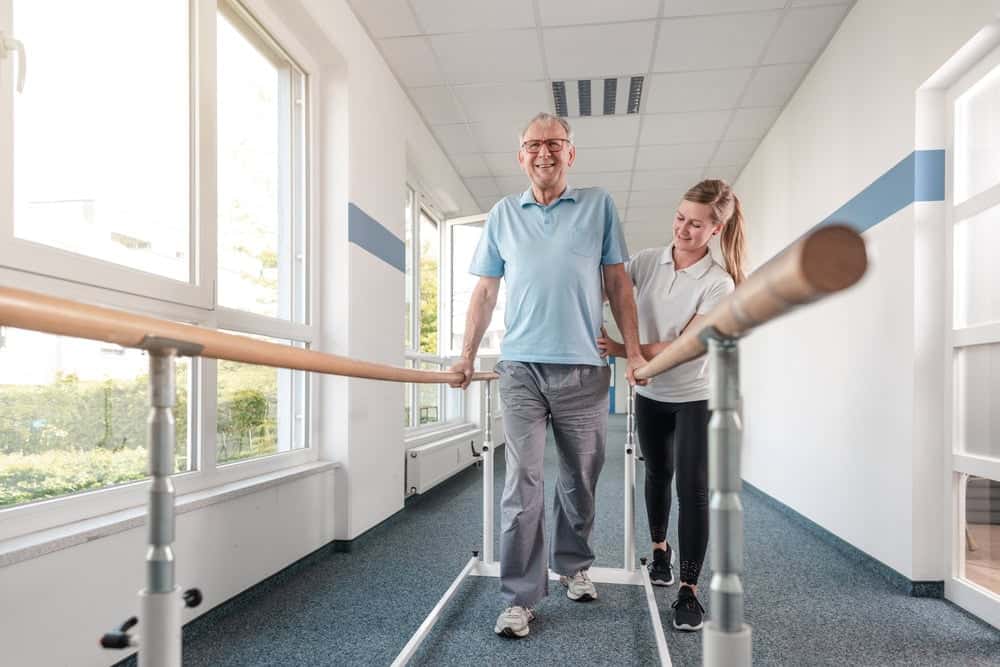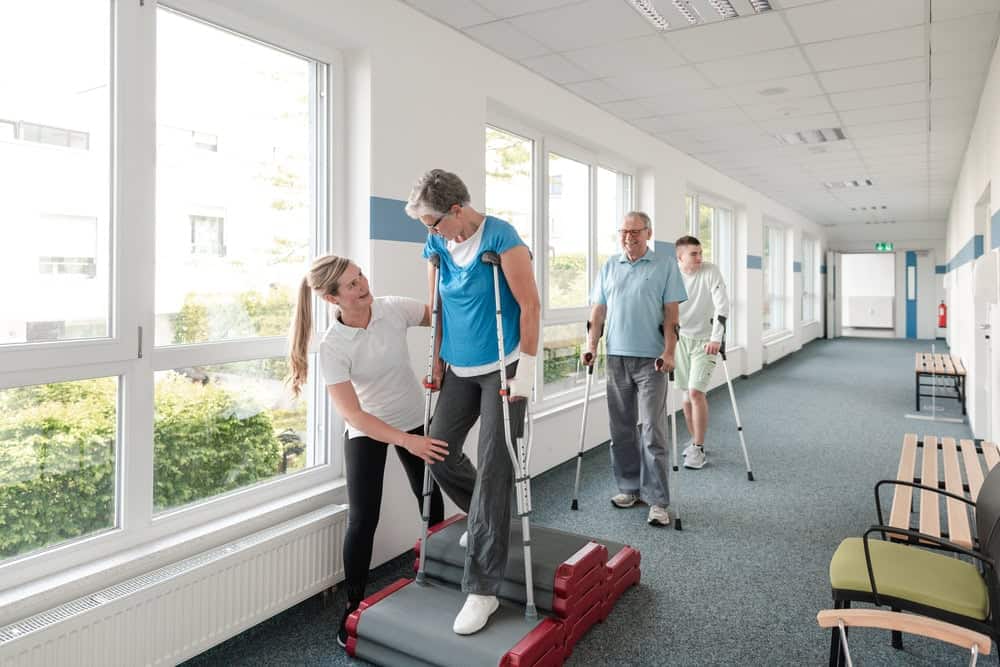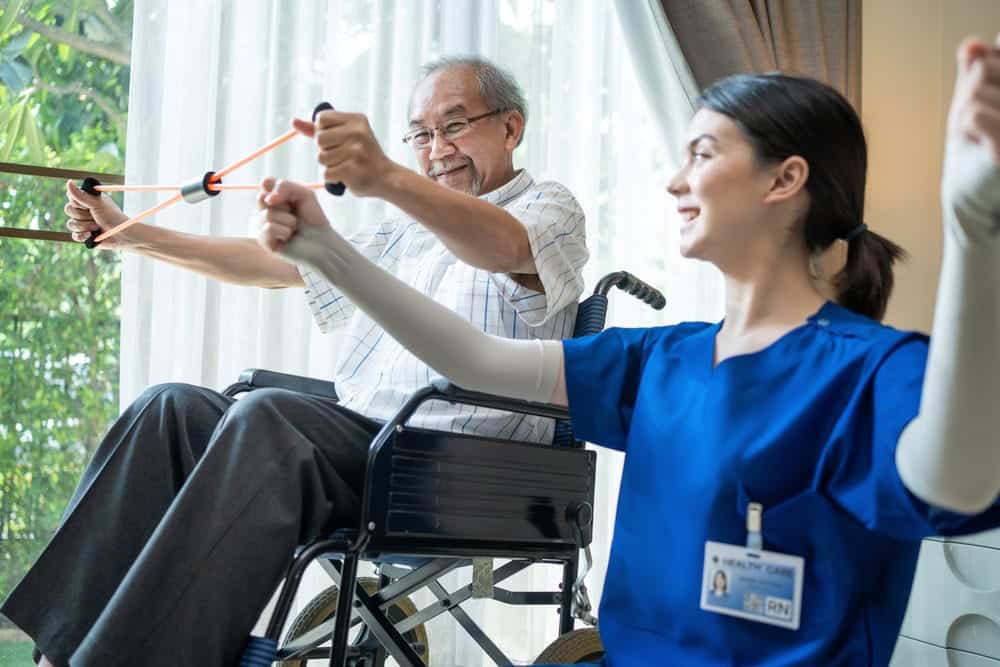
It’s no secret there’s a shortage of healthcare professionals around the world. Hospitals are understaffed because nurses, caregivers, and doctors are few. The population is aging. The need for skilled professionals who can help seniors improve their quality of life is on the roof.
Physical therapists are key players in this dynamic. They provide specialized care addressing the unique mobility challenges faced by older adults. Their interventions help seniors recover from injuries and surgeries to live more actively.
Are you thinking about becoming a physical therapist? Or are you curious about how they can help your loved one? In this article, you’ll learn the answers to these seven questions.
- What is a physical therapist?
- What is the training required to become one?
- What are the responsibilities of a physical therapist?
- What’s the career outlook like in this field?
- What are its benefits to seniors?
- What are the common conditions treated with physical therapy?
- What is its role in enhancing quality of life?
Learn a physical therapist’s day-to-day responsibilities and how they elevate the quality of senior care.
What is a Physical Therapist?
Physical therapists (PT) are important members of the healthcare team. They help seniors maintain their mobility, manage pain, and enhance their overall quality of life. Understanding their role can provide valuable insights into why they’re so significant.
A PT is a licensed healthcare expert who specializes in treating people with mobility problems. They’re trained to assess and diagnose movement dysfunctions. But their help doesn’t stop there — they also develop personalized treatment plans to improve your loved one’s physical abilities.
Part of a PT’s job description is to use a combination of techniques to help your senior parent restore their mobility after an injury or surgery. These methods include therapeutic exercises, manual therapy, and assistive devices.
These experts work in different healthcare settings. You’ll find them in hospitals, outpatient clinics, rehabilitation centers, nursing homes, and private practices. If you work with them, you’ll also receive educational support. They use a holistic care approach by assisting your entire family.
What Are the Training Requirements for Physical Therapists?

If you decide to pursue this profession, be prepared to commit to your education. You’ll learn about human anatomy, movement, and therapeutic techniques. The primary areas you’ll learn in the curriculum include some of these domains:
- Anatomy
- Cellular histology
- Physiology
- Biology
- Exercise physiology
- Kinesiology
- Neuroscience
- Biomechanics
If you want to make a career out of it, you must understand the requirements for education licensing and accreditation standards. This section summarizes what route to take to become a licensed physical therapist and makes it your source of living.
1. Getting Accredited and Licensed
To become a PT, you typically need to earn a bachelor’s degree in a related field such as exercise science or kinesiology, which usually takes four years. Afterward, you need to obtain a Doctor of Physical Therapy (DPT) degree from an accredited program. Ensure you choose an institution that meets the high standards required for the profession.
The Commission on Accreditation in Physical Therapy Education (CAPTE) is the primary accrediting body for PT programs in the U.S. It’s recognized by the Department of Education (USDE) and the Council for Higher Education Accreditation (CHEA).
A DPT program usually takes three years to complete. It includes both classroom instruction and clinical experience. After completing a DPT module, you must pass the National Physical Therapy Examination (NPTE) to obtain a license for practice. Each state may have additional requirements, so check with the local licensing board for specific details.
In a nutshell, you’ll spend about seven years in education to become a PT, which is quite long. The good news is some institutions offer combined bachelor’s and DPT programs to reduce the total time needed to become a licensed PT. Many people choose to take this route to shorten their education curve.
2. Specialization Options in the Field
After becoming a licensed physical therapist, you can choose to pursue a specialization. It allows you to focus on specific patient populations or types of treatment, enhancing your skills and career prospects. Some common specialties include:
Geriatrics
You’ll provide care for older adults. You’ll treat issues like arthritis, osteoporosis, and post-surgical rehabilitation.
Orthopedics
You’ll help treat musculoskeletal injuries. Seniors with fractures, sprains, and joint replacements will come to you.
Neurology
You’ll work with people who have neurological disorders, such as stroke, multiple sclerosis, and Parkinson’s disease.
Pediatrics
You’ll provide care for infants, children, and adolescents. They may have conditions like cerebral palsy, developmental delays, and congenital disabilities.
Sports physical therapy
You’ll work with athletes and help them prevent, treat, and rehabilitate sports-related injuries.
As a physical therapist, you have the option to choose a specialty you’re passionate about.
What Are the Responsibilities of a Physical Therapist?

The typical physical therapist job description covers a wide range of activities. These tasks include assessing patients, creating and developing a treatment plan, directing patient care and collaborating with other healthcare professionals.
Take a detailed look at the day-to-day duties of a PT who focuses on senior individuals.
Job Responsibilities
If you become a PT, your daily obligations can vary broadly depending on the work setting and the type of people you treat. Some common duties of a physical therapist for seniors include:
Assess patients
You’ll conduct thorough evaluations to understand a senior’s physical condition and limitations.
Develop treatment plans
You’ll create personalized rehabilitation plans. It often includes exercises, manual therapy, and other interventions to address specific issues.
Implement therapies
You’ll use techniques like therapeutic exercises and manual manipulation. In most cases, you’ll also use ultrasound or electrical stimulation as part of the treatment.
Monitor progress
You’ll also track the patient’s progress, adjust treatment plans as necessary, and document all important details.
Educate patients and families
Part of your responsibility is to teach seniors and their families about the rehabilitation process. You’ll advise what exercises to perform at home and strategies to prevent further injuries.
Collaborate with healthcare professionals
Expect to work with a team of doctors, nurses, and other healthcare providers. You’ll be part of the care team that ensures comprehensive patient care.
Working with Older Adults
You must understand the aging process and the specific challenges older adults face if you work with seniors. When providing care, you need to be patient and empathetic since they may have multiple health issues and deal with pain or fear of movement. Effective communication is key along with the ability to empower them to adhere to their treatment goals.
Collaborating with Other Healthcare Professionals
You’ll work as part of a multidisciplinary care team that includes physicians, nurses, and other therapists. Collaboration is essential in providing holistic care, addressing all aspects of a patient’s well-being. In this dynamic, you must maintain regular communication with team members to coordinate care and give the best possible care.
What’s the Career Outlook Like in Physical Therapy?

This field offers a promising and dynamic career path. Job prospects and growth opportunities are strong. The demand for healthcare services continues to rise. Therefore, the need for skilled physical therapists is also expected to skyrocket.
Learn about the job outlook of a PT, salary expectations, and various advancement opportunities. This way, you know what to expect in this rewarding profession.
Job Prospects and Growth in the Field
The demand for physical therapists is projected to grow significantly. Employment will grow 15% from 2022 to 2032, a much faster rate than the average for all occupations. This growth is driven by the growing aging population. Many will need a PT’s expertise to manage chronic conditions and recover from injuries.
Salary Expectations for Physical Therapists
Salaries can vary based on location, experience, and specialization. The median annual wage for physical therapists in May 2023 was $99,710 or $47.94 per hour. Those working in metropolitan areas and with advanced certifications may take home better pay. Your earning potential could also be higher if you’re employed at a specialized clinic or run a private practice.
Advancement Opportunities and Career Development
You also have various opportunities for career progression. Here are some common pathways to advance.
Specialization
Getting certified in subdomains like geriatrics, orthopedics, or neurology can enhance your expertise. In addition, it can open doors to higher-paying positions.
Management and administration
You may also advance to managerial or administrative roles. You’ll oversee departments, clinics, or rehabilitation centers.
Academia and research
If you’re interested in teaching or research, you can pursue academic positions or advanced degrees.
Private practice
After gaining more experience on your belt, you may choose to open your own clinic and offer specialized services.
Overall, the career outlook for physical therapists is robust. You can expect strong job growth and various opportunities. A rewarding career is in store for you if you become one. You can get a competitive salary and have numerous paths for specialization and growth. Physical therapy is a dynamic and fulfilling career that will help you achieve your professional and personal goals.
What Are the Benefits of Physical Therapy for Seniors?

Physical therapy is significant in meeting the unique needs of older people. As you or your loved one age, they experience a natural decline in physical abilities. These challenges lead to reduced mobility and increased risk of falls. Plus, the chance of chronic conditions such as arthritis, osteoporosis, and cardiovascular disease is likely.
Physical therapists are equipped with the knowledge and skills to address these problems. They can help seniors maintain their independence and quality of life. It offers numerous upsides that address physical and mental health. Older people can improve their mobility. Here are ways how PTs boost their overall quality of life.
1. Prevent fall and improve balance
Slipping and falling is a major risk among older people that often results in serious injuries such as fractures and head trauma. Physical therapists assess balance and gait abilities. They also design exercises that strengthen muscles and improve coordination. Interventions can reduce the risk of slips and fall.
How do they do it? They conduct a thorough assessment and create a balance training program for seniors who have a history of falls. This plan can include exercises to strengthen leg muscles. In addition, it improves proprioception, or the sense of perceiving the action and movement of several body parts. Doing this ultimately boosts an older loved one’s confidence and reduces accidents.
2. Manage pain
Chronic pain is a common complaint among older adults, often due to arthritis or previous injuries. Physical therapists use manual therapy, ultrasound, and electrical stimulation to boost general function.
If a loved one has chronic lower back pain due to osteoarthritis, they may receive manual therapy to relieve pain. A PT may also teach and recommend specific exercises to strengthen core muscles. Your senior mom or dad will learn proper body mechanics to prevent further strain. This comprehensive approach can reduce pain and boost daily function.
3. Help recover from surgery
If your loved one has undergone surgery like a hip or knee replacement, they’ll need therapy as part of their rehab program. It’s essential for postoperative recovery. Targeted exercises can help seniors regain strength, mobility, and function.
After a hip replacement surgery, a PT creates personalized exercise programs to strengthen the leg muscles and increase walking endurance. Over several weeks of therapy, your loved one can progress from using a walker to walking independently. As a result, they can resume their daily activities with little downtime and enjoy their favorite hobbies.
4. Manage chronic conditions
Parkinson’s disease, stroke, and multiple sclerosis can affect your loved one’s ability to complete daily tasks. A PT maps out an individualized treatment plan to manage these conditions. Adhering to it can ultimately improve mobility and enhance the overall quality of life.
Suppose your loved one has a stroke attack. In this case, a PT can work with them to restore function through targeted exercises and mobility training. Seniors can reclaim their independence this way.
5. Increase strength and endurance
Physical therapy programs are designed to enhance overall strength and endurance. After an effective treatment, seniors can likely perform daily tasks more efficiently and with less fatigue. This increased strength makes walking, climbing stairs, and carrying groceries easier and safer.
For example, your loved one may participate in strength-training exercises. After several weeks, they may be able to carry groceries without straining their muscles or feeling exhausted easily.
6. Boost flexibility and range of motion
Regular physical therapy can help expand your loved one’s flexibility and range of motion. It’s particularly important for older people since aging can make muscles and joints stiff. Participating in the program will make it easier for them to perform daily activities. Moreover, it curbs the risk of injuries from sudden movements or falls.
After consistent flexibility training, your senior mom or dad may find it easier to reach for items on top shelves or bend down to pick up objects from the floor.
7. Enhance posture
Good posture is essential for reducing strain on the body and preventing injuries. Physical therapists work with seniors to correct postural imbalances, fix alignment, and develop habits that support better form in everyday activities.
A senior with chronic neck and back pain can benefit from learning posture techniques and exercises. It will help alleviate pain and improve their stature over time.
8. Increase independence and confidence
Physical therapy programs can help older adults regain confidence in their movements and daily activities. This newfound self-esteem can lead to greater independence and a more active lifestyle.
After completing an exercise program, your loved one may feel more confident walking around. They’re also more likely to participate in community events because of this renewed trust in themselves.
9. Enhance Quality of Life
Physical therapists also support emotional and mental well-being. By helping seniors stay active and independent, PTs empower seniors to participate in social activities and hobbies. An active lifestyle reduces feelings of isolation and depression. This holistic approach to care is important in elevating their quality of life and living more meaningfully.
What Are Common Conditions Treated With Physical Therapy?

Seniors face various health challenges that can impact their ability to be self-sufficient. Physical therapists can intervene to manage these conditions and help older people sustain their function. As a result, they can live more actively and enjoy their golden years.
Here are some common conditions treated with physical therapy.
Arthritis
Osteoarthritis and rheumatoid arthritis are prevalent in seniors. These concerns cause joint pain and stiffness and limit mobility. A PT uses exercises to strengthen the muscles around the joints, improve flexibility, and soothe pain. The result is that older people can continue with their daily activities.
Osteoporosis
This condition weakens bones, making older people more prone to fractures. Physical therapy focuses on weight-bearing and resistance exercises. The goal is to strengthen the musculoskeletal system and improve balance to reduce the risk of falls and fractures.
Stroke
Following a stroke attack, many seniors experience impaired movement, speech, and cognitive functions. Through specialized exercises and techniques, a PT can teach them how to regain motor skills, fix balance problems, and restore strength and coordination.
Parkinson’s Disease
This neurodegenerative disorder affects movement and balance. Physical therapy can help minimize symptoms by focusing on exercises that improve gait, balance, strength, and flexibility. A PT teaches strategies to overcome movement difficulties and reinforce daily function.
Hip and knee replacements
Physical therapy is critical for recovery after joint replacement surgery. A PT develops postoperative rehab plans to restore strength, flexibility, and range of motion. It helps seniors get back to their normal activities with little downtime.
Chronic pain
Conditions like fibromyalgia and chronic lower back pain can be debilitating. A PT uses various techniques to moderate pain, improve strength and agility, and teach patients. They also teach techniques on how to manage symptoms.
What’s the Role of Physical Therapists in Enhancing Quality of Life?

They help seniors live a satisfying life through the following ways:
Personalized Care
Part of the physical therapist’s job is to assess each senior’s unique needs and create individualized treatment plans. This person-centered approach ensures therapy intervention is targeted. As a result, the treatment plan is more effective at addressing the challenges unique to the person.
Education
PTs teach seniors and their families safe ways to exercise at home, manage symptoms and make lifestyle changes for robust health. This knowledge empowers them to take an active role in caring for their well-being.
Holistic care
PTs consider the physical, emotional, and psychological health factors. They provide all-inclusive support and encouragement and help your loved one stay engaged in recreational activities.
Preventive Care
They also pay attention to preventive care, helping your senior mom or dad prevent injuries and complications. Regular therapy sessions can identify potential issues early. It allows PTs to address problems before they become severe.
How Can a Physical Therapy Career Be Rewarding?
A career in this field comes with its challenges and rewards. The profession demands physical stamina and emotional resilience. You’ll also have to set aside time for ongoing learning. In exchange, it offers personal satisfaction and the opportunity to make a tangible difference in people’s lives.
Learn more about the fulfilling aspects of being a physical therapist and the challenges you may face if you pursue it, including the strategies for overcoming these hurdles to thrive in this field.
Fulfilling Aspects of Working as a Physical Therapist
The best aspect of being a PT is the opportunity to influence other people’s lives. As a PT, you can help seniors regain their independence and improve their overall condition. Seeing patients progress and achieve their goals can be incredibly fulfilling.
In addition, it also pays well. It’s a great career option if you’re looking for a job that’s financially and personally rewarding.
Challenges Faced By Physical Therapists
Physical therapists also go through many challenges, especially if your focus is seniors. You’ll work with those with complex medical conditions, which can be physically and emotionally demanding. Besides your typical duty as a PT, you’ll have admin tasks to take care of.
Strategies to Thrive in the Field
To overcome these challenges, here are some tips to keep in mind:
- Continue your education: Stay updated with the latest treatment techniques to improve your clinical skills.
- Practice self-care: Prioritizing your physical and mental health. Exercise regularly. Get sufficient shuteye. Learning to manage stress with relaxation techniques. Fill your daily plate with wholesome foods.
- Build a support network: Join professional organizations that provide valuable support and resources. As a job in healthcare can feel isolating, building a support network is beneficial for your social health.
A Career as a Physical Therapist Is Rewarding

Physical therapists play a vital important role in senior care. They offer support to improve mobility, manage pain, and enhance older people’s overall quality of life. Their skills can help seniors maintain independence and live meaningfully.
What makes this career extremely rewarding is the opportunity to make a positive impact on others. With a strong job outlook and competitive salary, you’ll find this career financially fulfilling, too. If you’re passionate about helping others and interested in the science of movement, a PT could be the perfect career choice for you.
On the other hand, if you’re looking for a reliable physical therapist to support your loved one, Amy’s Eden Senior Care has partnered with many reliable healthcare professionals, offering rehabilitation programs at home. Our network of PTs offers individualized treatment programs to meet your loved one’s care needs. Begin your journey to recovery right in the comfort of your home.
Meta description: A physical therapist is a movement expert, they work with patients to improve their mobility and manage pain. Learn more about a physical therapist job description.





